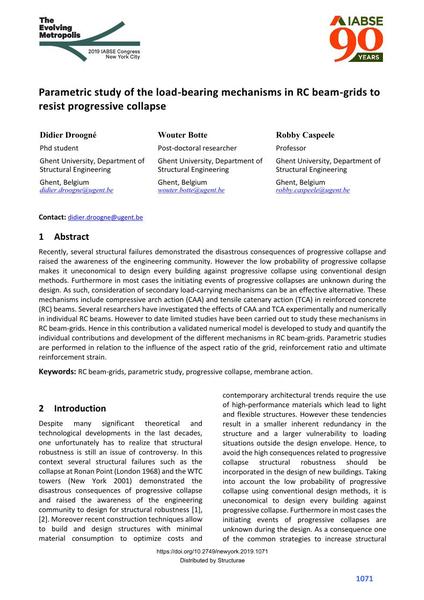Parametric study of the load-bearing mechanisms in RC beam-grids to resist progressive collapse

|
|
|||||||||||
Détails bibliographiques
| Auteur(s): |
Didier Droogné
(Ghent University, Department of Structural Engineering)
Wouter Botte Robby Caspeele |
||||
|---|---|---|---|---|---|
| Médium: | papier de conférence | ||||
| Langue(s): | anglais | ||||
| Conférence: | IABSE Congress: The Evolving Metropolis, New York, NY, USA, 4-6 September 2019 | ||||
| Publié dans: | The Evolving Metropolis | ||||
|
|||||
| Page(s): | 1071-1078 | ||||
| Nombre total de pages (du PDF): | 8 | ||||
| DOI: | 10.2749/newyork.2019.1071 | ||||
| Abstrait: |
Recently, several structural failures demonstrated the disastrous consequences of progressive collapse and raised the awareness of the engineering community. However the low probability of progressive collapse makes it uneconomical to design every building against progressive collapse using conventional design methods. Furthermore in most cases the initiating events of progressive collapses are unknown during the design. As such, consideration of secondary load-carrying mechanisms can be an effective alternative. These mechanisms include compressive arch action (CAA) and tensile catenary action (TCA) in reinforced concrete (RC) beams. Several researchers have investigated the effects of CAA and TCA experimentally and numerically in individual RC beams. However to date limited studies have been carried out to study these mechanisms in RC beam-grids. Hence in this contribution a validated numerical model is developed to study and quantify the individual contributions and development of the different mechanisms in RC beam-grids. Parametric studies are performed in relation to the influence of the aspect ratio of the grid, reinforcement ratio and ultimate reinforcement strain. |
||||
